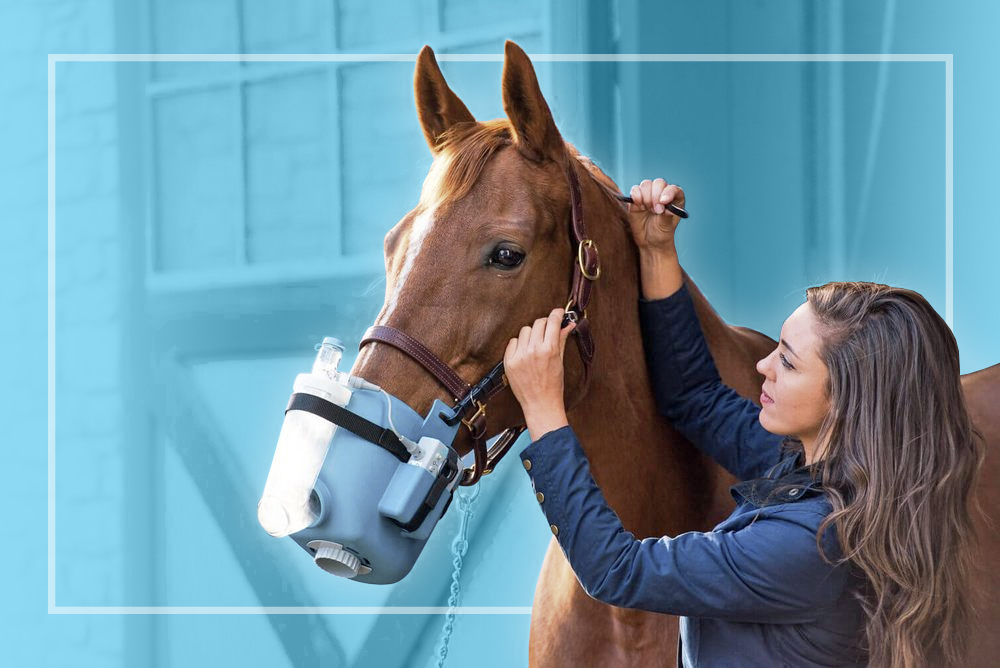K. FISCHER
Veterinary Surgeon, Tierärztliche Klinik für Pferde – Grosswallstadt.
Study subject
The nine-year-old Quarter Horse gelding Laredo belonging to the Western rider Tasja Berger (Western sport: Pleasure, horsemanship...) was the focal point of the longitudinal study carried out recently and clinically monitored. The aim of the study was to find out if, and to what extent, our patient could be helped on a sustainable basis using regular inhalation carried out by a Flexineb inhaler.
Starting situation
The horse was known to our hospital for a few years as a patient with a recurring cough. He suffered from allergic bronchitis, which always got worse in the spring. This diagnosis was clarified before our study started by clinical investigation of the respiratory tract, blood gas analysis, endoscopy and an allergy test. As it is intended that the horse should continue to be shown because of his outstanding ability, we tried to find a way of treating his lung disease under the best possible conditions despite his lung problems and without coming into conflict with the “doping regulations”. The possibility of using inhalation was chosen for this objective along with desensitisation therapy. In so doing, the inhalation substances were each selected in conformity with ADMR in line with the intervals before the next show.
Control
Supervision and control of results were carried out at regular intervals (approx. every four weeks) within the framework of a bronchoscopy performed on a horse which has not been sedated. In addition, the blood gas values were checked several times.
Results and implementation
Initial investigations took place in April 2013, thus at a point in time when very many allergenic substances were in the air. When the initial investigation took place, the blood gas showed a reduced oxygen value of 84 mm Hg (pCo2 45 mm Hg, AaDO2 20.3). An endoscopy revealed that more than one third of the trachea was largely covered with glutinous mucus. The tracheal mucous membrane showed clear redness and the larynx area was red also (M5, V3-4; according to Diekmann, 1987). The horse showed a marked need to cough during the investigation.
The result of the allergy test showed allergic reactions to numerous allergens, both year round (Aspergillus fumigatus) and seasonal (birch, amongst others). Appropriate desensitisation therapy was commenced, which was carried out in parallel with the other treatments. Acetylcystein, Ventipulmin® and Prednisolon were fed for a fortnight prior to starting the inhalation therapy. Liquid Acetylcystein was initially inhaled as a lead-in to the inhalation therapy. An initial bronchoscopy control in May 2013 already clearly showed more liquid mucus and a reduction in the quantity. However, the redness of the mucous membrane was still present (M3-4, V2-3). A repeat endoscopy four weeks later in June 2013 following inhalation only of table salt solution showed markedly less inclination to cough, a reduced quantity of mucus in the trachea and, in addition, less glutinous mucus than when first investigated (M2, V2). At this point in time, the blood gas values remained almost unaltered compared with the initial investigation. The subsequent investigation in July 2013, on this occasion following regular inhalation of Acetylcystein, fortunately showed no inclination to cough any more in the patient during investigation and once more less redness of the mucous membrane. In addition, we were able to establish that once again less thin mucus was present. The mucus appeared to be more liquid than when only inhaling table salt solution (M2, V1 -2). After a further four weeks and treatment again using only table salt solution, the investigation in August 2013 also showed less thin mucus in the trachea. The redness of the mucous membrane was less marked (M1 -2, V1 -2), just as the blood gas values (pO2 95 mm Hg and pCO2 38 mm Hg; A-aDO2 16.3) had also improved. When the final investigation was carried out at the end of September 2013 and a treatment phase of Acetylcystein inhalation had taken place, only very little thin secretion was present in the trachea (M1, V1). The horse showed no inclination to cough during the investigation. The blood gas result had improved again (po2 100 mm Hg, pCo2 42 mm Hg, A-aDO2 7). We were therefore able to bring treatment to a close.


